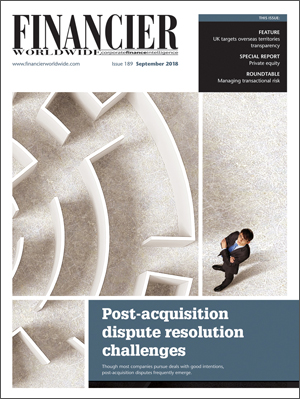Harvey Gulf exits bankruptcy
September 2018 | DEALFRONT | BANKRUPTCY & CORPORATE RESTRUCTURING
Financier Worldwide Magazine
In early July, Harvey Gulf International Marine announced that it had completed its restructuring and was emerging from Chapter 11 bankruptcy protection after a little over two months.
The company filed for Chapter 11 protection in March in the Houston federal bankruptcy court for South Texas. According to documents filed with the court, Harvey Gulf’s estimated liabilities were between $1bn and $10bn. The company’s debtors secured support for a prepackaged Chapter 11 plan of reorganisation from holders of senior lenders claims “representing over 94 percent in number and more than 75.5 percent in dollar amount of those creditors in the voting class casting votes on the plan, excluding the votes of insiders”.
According to the company’s restructuring plan, prepetition lenders were to receive their pro rata share of a $350m term loan and additional distributions of equity and warrants. Following emergence from Chapter 11, the prepetition lenders were to control the significant majority of the new equity in Harvey Gulf and were to appoint a majority of the new board of directors. Though this plan was largely approved, one dissenting lender filed an objection.
After emerging from bankruptcy, Harvey Gulf, which has more than 50 vessels in its fleet and supplies offshore oil rigs among other services, also announced that it had reached an agreement with Shane Guidry, the company’s chairman and chief executive, to extend his employment contract for an additional five years. The retention of his services and the rest of his senior management team was a key tenet of the restructuring, the company said.
“The Chapter 11 restructuring process is extremely complicated, and the fact that Harvey Gulf emerged so quickly, while shedding a billion dollars of debt and adding over 40 new customers, reflects the dedication, hard work, and tenacity of the entire Harvey Gulf team,” said Mr Guidry. “Importantly, Harvey Gulf’s performance will continue well into the future, and the competition simply isn’t in a position to capitalise on the industry’s shift to cleaner energy. Nor are they capable, either financially or from the organisational leadership standpoint, of re-designing their fleets to compete and perform in this new age.
“I want to thank my lenders, who are now my new partners, and Harvey Gulf’s legal and financial advisors, Vinson & Elkins, LLP, Blank Rome, LLP, and Stephens Inc., as well as our lenders’ attorneys and advisors, led by Davis Polk & Wardwell, LLP and PJT Partners, LP, for all the long hours we’ve all worked together to position Harvey to be able to deliver another 63 years of safe and efficient, family run vessel services to all our very appreciated customers and partners in safety. Lastly, I’d like to thank The Jordan Company, which has been a tremendous partner for us over the last 10 years and supportive of this company through any and all challenges. We are glad that TJC will maintain a significant stake in the company going forward,” he added.
Harvey Gulf’s financial difficulties began with the offshore slump of 2014. As a result of the industry-wide slump, the company began to take steps to defend its position due to what it described as “considerable vessel oversupply in the marketplace”.
The first quarter of 2014 saw the company cut costs by around $87m, in part by reducing its crews by 45 percent, reducing general and administrative positions by 50 percent, by cutting bonuses and executive compensation, and by suspending 401(k) contributions.
Harvey Gulf is one of a number of companies to suffer following the drop in oil prices in 2014. The slump had a devastating effect on the shipping and rigging industry. Demand for rigs fell sharply and a number offshore drilling and service companies such as Seadrill Ltd and Ocean Rig UDW Inc also filed for bankruptcy protection. Yet, despite the downturn in the industry’s fortunes, Harvey Gulf pursued an ambitious and potentially risky new building programme of offshore support vessels (OSVs), including the Gulf of Mexico’s first LNG-powered OSV. However, the gamble was unsuccessful. In March 2017, Harvey Gulf was downgraded by Moody’s and in September 2017 it failed to make payments due on its debt and entered into a forbearance agreement with its lenders.
© Financier Worldwide
BY
Richard Summerfield

